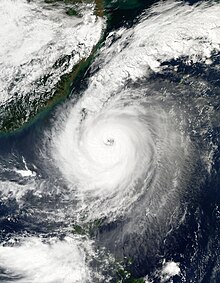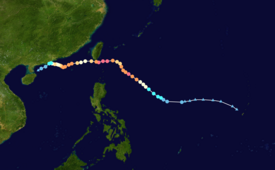 Koinu at peak intensity while nearing landfall on Taiwan on October 4 Koinu at peak intensity while nearing landfall on Taiwan on October 4 | |
| Meteorological history | |
|---|---|
| Formed | September 28, 2023 (2023-09-28) |
| Dissipated | October 9, 2023 (2023-10-09) |
| Very strong typhoon | |
| 10-minute sustained (JMA) | |
| Highest winds | 165 km/h (105 mph) |
| Lowest pressure | 940 hPa (mbar); 27.76 inHg |
| Category 4-equivalent typhoon | |
| 1-minute sustained (SSHWS/JTWC) | |
| Highest winds | 220 km/h (140 mph) |
| Lowest pressure | 936 hPa (mbar); 27.64 inHg |
| Overall effects | |
| Fatalities | 1 |
| Injuries | 399 |
| Missing | None |
| Damage | $18 million (2023 USD) |
| Areas affected |
|
| IBTrACS | |
Part of the 2023 Pacific typhoon season | |
Typhoon Koinu, known in the Philippines as Typhoon Jenny, was a strong and damaging tropical cyclone that made landfall on the southern tip of Taiwan and affected Hong Kong. Koinu, a replacement name for Tembin which means puppy or Canis Minor in Japanese, was the fourteenth named storm and ninth typhoon of the inactive 2023 Pacific typhoon season. Koinu originated from an area of low pressure near Guam that generally moved westward into the Philippine Sea, where it was upgraded into a depression.
Koinu later underwent rapid intensification and became a Category 3-equivalent typhoon. The storm then weakened before intensifying to attain its peak intensity as a category 4-equivalent typhoon. Koinu passed close by Lanyu then made landfall over Hengchun, Taiwan.
Meteorological history
| This section needs additional citations for verification. Please help improve this article by adding citations to reliable sources in this section. Unsourced material may be challenged and removed. (December 2023) (Learn how and when to remove this message) |

Map key Saffir–Simpson scale Tropical depression (≤38 mph, ≤62 km/h)
Tropical storm (39–73 mph, 63–118 km/h)
Category 1 (74–95 mph, 119–153 km/h)
Category 2 (96–110 mph, 154–177 km/h)
Category 3 (111–129 mph, 178–208 km/h)
Category 4 (130–156 mph, 209–251 km/h)
Category 5 (≥157 mph, ≥252 km/h)
Unknown Storm type
 Tropical cyclone
Tropical cyclone  Subtropical cyclone
Subtropical cyclone  Extratropical cyclone, remnant low, tropical disturbance, or monsoon depression
Extratropical cyclone, remnant low, tropical disturbance, or monsoon depression On September 27, a low-pressure area formed near Guam, with the JTWC indicating the potential development of a tropical cyclone. It moved westward into the Philippine Sea until it entered the Philippine Area of Responsibility, where it was later upgraded into a tropical depression and gained the name Jenny by the PAGASA. A Tropical Cyclone Formation Alert was then issued for Jenny as it began to show signs of further organization. Hours later, JTWC gave its identifier 14W at 13:00 UTC (21:00 PHT). On September 28, JMA upgraded 14W into a tropical storm and attained the name Koinu, which replaced the name Tembin. PAGASA later followed suit at their 5 AM PHT bulletin, also upgrading Jenny into a tropical storm; JTWC followed thereafter.
Koinu moved west northwestward in the Philippine Sea whilst having its low-level circulation exposed due to wind shear. Koinu then later organized further, and by the next day, the JMA upgraded Koinu into a severe tropical storm. As usual, the PAGASA followed suit a few hours later. Koinu later gradually intensified into a Category 1 typhoon by the JTWC. The other agencies also followed suit in upgrading Koinu into a typhoon as an eye began to form. Koinu then began a period of rapid intensification by the evening of October 1 into the early morning hours, intensifying to become a low-end Category 4 typhoon whilst it developed a clear eye as it moved east of Cagayan before weakening slightly. Koinu weakened to Category 2 strength yet rebounded its intensity and reached Category 4 again whilst nearing Taiwan and moving west northwestward. Koinu passed dangerously close to Lanyu, and making its first landfall on mainland Hengchun, Taiwan, later weakening into a Category 3 storm as it did so. Koinu then weakened into a Category 1 after slamming into Taiwan and later exited the PAR into the South China Sea. Contrary to forecasts, Koinu unexpectedly restrengthened back into a Category 2, reforming a clear visible eye surrounded by a powerful eyewall. Koinu further intensified, regaining Category 3 status east of Guangdong.
After re-intensifying, Koinu weakened again for the last time, as it started to move west-northwestward. Dry air intrusion and land interaction continued to weaken the system into a tropical storm on October 9. Afterwards, it weakened to a tropical depression before reaching the Leizhou Peninsula into the Gulf of Tonkin. Both agencies ceased their advisories as Koinu weakened into a remnant low on October 10.
Preparations and impact
Philippines
As Typhoon Koinu (known as Jenny in the Philippines) approached the Northern Philippines including Extreme Northern Luzon, the PAGASA began issuing warnings for parts of Northern Luzon, and a few days later, Signal #3 was raised on Itbayat, Batanes as the typhoon brought showers and gusty winds to the islands.
As Jenny moved further away and weakened, the rains and winds started to subside, however, locals were still warned that the storm may still trigger moderate to rough seas in the areas affected.
Taiwan
Taiwanese authorities issued weather warnings in preparation of strong gusts and heavy rain hitting the island's southeast. According to news sources, flights were canceled, schools and businesses were closed, and fishermen secured their boats. While the storm is likely to bring the most rain to hilly and sparsely inhabited areas, it will also affect the large port city of Kaohsiung.
As Koinu made landfall, it brought record-breaking winds and rains. A weather station on Orchid Island recorded gusts of winds of 198.7 kilometres per hour (123.5 mph) at 9:40 p.m. and gusts of 342.7 kilometres per hour (212.9 mph) 13 minutes later, both representing record-highs since record-keeping began in 1897. Many trees fell down on roads and damaged infrastructure. A landslide occurred on Provincial Highway No. 9 in Pingtung County forcing vehicles to drive on the same lane, while 2 roads in Taitung County, Provincial Highway 20 in Haiduan Township and Provincial Highway 23 in Donghe Township were blocked.
Agricultural losses in Taiwan were about NT$344.56 million (US$10.72 million), according to the Ministry of Agriculture (MOA). The five administrative areas that sustained the greatest losses were Yunlin, Changhua, Taichung, Chiayi, and Tainan. Around 9,762 hectares of crops were damaged. Peanuts were the crop that sustained the largest losses, while chickens and pigs were the largest livestock and poultry losses.
Hong Kong
As Typhoon Koinu neared Hong Kong, the Hong Kong Observatory (HKO) issued Increasing Storm Signal No. 9 at 19:00 (HKT) and weather warnings in preparations for heavy rainfall and strong winds ahead of the storm. The agency then considered if they would hoist their second Hurricane Signal No. 10 since Typhoon Saola if the storm passed further closely to Hong Kong.
However, as Koinu moved away from Hong Kong and started weakening, the HKO did not need to issue the highest wind signal. The Increasing Storm Signal No. 9 was kept in force for 4 hours before lowered it down to Southwest Gale or Storm Signal No. 8.
See also
- Weather of 2023
- Tropical cyclones in 2023
- Typhoon Nepartak (2016)
- Typhoon Meranti (2016)
- Typhoon Haikui (2023)
- Typhoon Saola (2023)
References
- "Tropical Cyclone Bulletin #1 for Tropical Depression "Jenny"" (PDF). PAGASA. Retrieved October 8, 2023.
- Chien, Amy Chang; Young, Jin Yu; Yoon, John (October 4, 2023). "Typhoon Koinu Intensifies and Brings Heavy Rain and Winds to Taiwan". The New York Times. ISSN 0362-4331. Retrieved October 5, 2023.
- Cabrera, Romina (October 6, 2023). "Jenny exits; rains to continue over Northern Luzon". Philippine Star. Retrieved October 8, 2023.
- Casucian, Jiselle (October 3, 2023). "Typhoon Jenny maintains strength, Signal No.3 raised over Itbayat, Batanes". GMA News Online. Retrieved October 4, 2023.
- Arceo, Acor (October 6, 2023). "Typhoon Jenny weakens outside PAR, has no more direct effect". Rappler. Retrieved November 11, 2023.
- "Taiwan Braces for Typhoon Koinu". NASA Earth Observatory. October 3, 2023. Retrieved October 8, 2023.
- "Taiwan issues rain and strong wind alerts for Typhoon Koinu that's approaching the island". AP News. October 3, 2023. Retrieved October 8, 2023.
- "Typhoon Koinu brings Taiwan's highest-ever wind speeds to Orchid Island". Focus Taiwan. October 5, 2023. Retrieved November 11, 2023.
- "Typhoon Koinu kills 1, injures nearly 400 in Taiwan". Focus Taiwan. October 6, 2023. Retrieved November 11, 2023.
- Hsiung-feng, Chang; Lo, James (October 8, 2023). "Typhoon Koinu agricultural losses estimated at NT$340 million". Focus Taiwan - CNA English News. Retrieved November 11, 2023.
- "Typhoon Koinu: Hong Kong raises T9 storm signal, MTR commuters left stranded as Observatory to consider T10". Hong Kong Free Press. October 8, 2023. Retrieved October 8, 2023.
- "Typhoon Koinu skirts Hong Kong, heads for southern China's Hainan island". Phys.org. Retrieved October 9, 2023.
External links
| Tropical cyclones of the 2023 Pacific typhoon season | ||
|---|---|---|
 | TDTD TDAmang TSSanvu TDTD VITYMawar TYGuchol TDTD STSTalim VSTYDoksuri VSTYKhanun TDTD VSTYLan TYDora TDTD VITYSaola STSDamrey VSTYHaikui TSKirogi TDTD TSYun-yeung TDTD TDTD TDTD TD13W VSTYKoinu VITYBolaven TSSanba TD17W TSJelawat | |
- 2023 Pacific typhoon season
- 2023 in the Northern Mariana Islands
- 2023 in Guam
- 2023 in Hong Kong
- 2023 in Macau
- September 2023 events in Oceania
- October 2023 events in Oceania
- September 2023 events in the United States
- October 2023 events in the United States
- October 2023 events in the Philippines
- October 2023 events in Taiwan
- October 2023 events in China
- 2023 natural disasters in the United States
- 2023 disasters in the Philippines
- 2023 disasters in Taiwan
- 2023 disasters in China
- Typhoons in the Philippines
- Typhoons in Taiwan
- Typhoons in China
- Typhoons in the Northern Mariana Islands
- Typhoons in Guam
- Typhoons in Hong Kong
- Typhoons in Macau